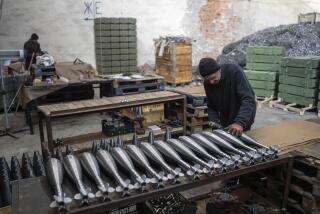There’s More Hope Than Havoc in Defense Downsizing
- Share via
With bright hope but also nagging anxiety, Americans will welcome Soviet President Mikhail Gorbachev this week as he arrives for the May 31-June 3 summit meeting.
The hope, of course, is that the Soviet Union’s economic and political reforms and its withdrawal from Eastern Europe will bring the United States relief from Cold War tensions and costly weapons expenditures.
The anxiety is that sharp reductions in the $300-billion U.S. defense budget will cause rising unemployment and business failures across the country--and particularly in Southern California. Estimates within the aerospace-defense industry say the budget will fall 10% a year in the early ‘90s to less than 4% of the gross national product, a level not seen since the aftermath of World War II.
And truth is, there’s good reason for both the rosy and the scary scenarios--but perspective is needed.
Yes, the defense budget will fall, but how much and in what way depends on a lot of things. Most crucially, “it depends on the pace of events in the Soviet Union,” observes James Thomson, president of RAND Corp., the Santa Monica think tank that does policy research for the government.
In all the talk of peace dividends, little mention has been made of the Soviet military and its thinking. Yet concern over a growing technology gap is one of the driving forces behind Gorbachev’s reforms.
The Soviet military has long worried about the edge that electronic technology gives to the West--in NATO’s ability to monitor troop movements from afar or to computerize weapons to fire accurately at great distances--in short, to engage in “remote-control” warfare.
Former Soviet chief of staff Nikolai Ogarkov and his officers reportedly have been trying to come up with new kinds of non-nuclear weapons to make the odds more equal. These could include precision bombs powered by fuel-air mixtures and communications systems and laser weapons based in space--where the Soviets have been strong since Sputnik.
Those concerns mean that the Soviets will be making an effort to improve military technology even as perestroika shifts overall resources to the civilian economy.
Where will the Soviets get technology that they don’t have now? Through East European countries, where Soviet armies will continue to exert authority even as those countries open to the West. U.S. officials recently in Moscow report that the loss of Eastern Europe--and especially the reunification of Germany--are just now sinking in, bewildering and angering Soviet officialdom. (World War II cost 20 million Soviet lives.)
One result is that the Soviets are balking at further troop withdrawals from Germany and Eastern Europe. And while they may ultimately make a deal to pull troops back, they will demand continued access to Western technology. That may be no big threat; it’s a real question whether the Soviets can truly adapt the technology.
But their effort should ensure that U.S. spending on military and space research and development will be spared severe cutbacks. There will be funding for research into laser controls that allow planes to “fly by light,” for example, or into the National Aero-Space Plane.
Beyond R&D;, however, U.S. defense cuts will be deep. “They’ll be at least as great as they were after 1968, when the Vietnam buildup peaked,” says analyst George Sha piro of Salomon Bros. Defense spending fell 40% between 1968 and 1976--”and the Cold War was still going on,” he adds.
So where will discharged service personnel and laid-off aerospace employees get jobs?
And, another question: Why is U.S. military technology so seldom adapted for civilian industry? Commercial spinoffs from the Pentagon could create jobs and boost U.S. competitiveness.
The answers lie partly in a consolation, but partly also in possibilities. The consolation is that U.S. business is facing a shortage of skilled people in the ‘90s--and may welcome the trained personnel coming out of defense and the armed forces. Looking for work is never easy, but a labor-tight, growing economy may offer a better chance.
As for military technology, the real story is that its adaptability to commercial use may be underrated. To be sure, it’s hard to see how an affordable commercial product could be made from, say, the ability of Air Force satellites to photograph grains of Russian wheat from 100 miles up. The technology is too advanced and expensive for commercial use.
But innovative thinking could translate the concept behind satellite photography--perhaps considering how such long-distance vision might be adapted to airliners or trucks and highways.
Technology transfer is normally unpredictable--and even unseen. For example, years ago it was said that Tang, the breakfast drink, was one of the few commercial spinoffs of the Apollo space program. But that was ridiculously narrow. In fact, the most important byproducts of the 1960s space program were the microchips of the ‘70s and the microprocessors of the ‘80s--the technological advances that forced the Soviet Union to think about reform.
Maybe what the defense industry needs to do right now is brainstorm with venture capitalists in Silicon Valley.
The point, of course, is that the current time is pregnant with possibilities. And the profound changes that Gorbachev, Eastern Europe and Soviet reform represent, mean the ‘90s offer more cause for hope than anxiety.
More to Read
Sign up for Essential California
The most important California stories and recommendations in your inbox every morning.
You may occasionally receive promotional content from the Los Angeles Times.










